To document care expenses for tax deductions, gather all receipts and invoices showing payments, including provider details and service dates. Keep detailed records of each payment, categorizing expenses like supplies or services, and regularly update them. Use digital tools to organize and store these records securely, ensuring easy access later. Don’t forget to track reimbursements or refunds. Continuing with these steps will help you build a solid, audit-ready documentation system.
Key Takeaways
- Collect and organize all receipts, invoices, and bank statements that prove payments and expenses.
- Digitize receipts promptly using apps or scanners, and store them in labeled folders or cloud storage.
- Track each payment with details like date, amount, payee, and service to maintain accurate records.
- Categorize expenses by type (e.g., supplies, services) and date for easier verification and reporting.
- Use digital tools and apps to synchronize, back up, and organize records for efficient tax preparation.
Gather All Relevant Receipts and Invoices
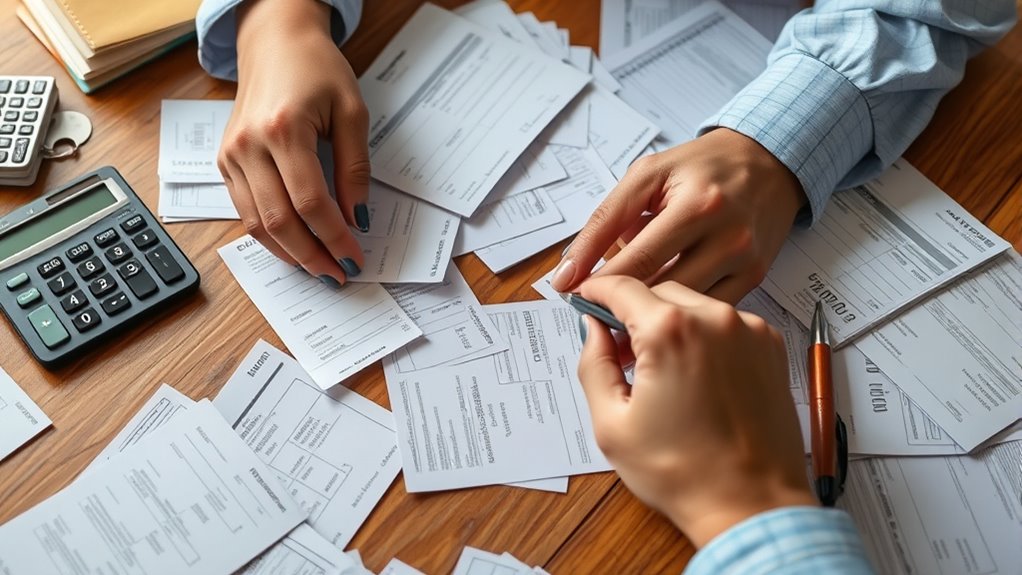
To accurately document your care expenses for tax deductions, you need to gather all relevant receipts and invoices. Collect every proof of payment related to medical services, caregiving, or supplies. Make sure the receipts include the provider’s name, date of service, description, and amount paid. Organize these documents in a dedicated folder or digital file for easy access. Avoid mixing unrelated receipts to prevent confusion during tax time. If you paid by credit card or bank transfer, download statements that show the transactions. Keep original receipts whenever possible, but digital copies are acceptable if they clearly display all necessary details. Staying organized now guarantees you won’t have trouble verifying your expenses when it’s time to file your taxes. Incorporating proper record-keeping practices ensures your documentation maintains accuracy and completeness. Paying attention to detailed record organization can streamline the process and reduce errors during tax filing, especially when verifying expenses related to necessary cookies that enable basic site functionalities.
Keep Detailed Records of Payments Made
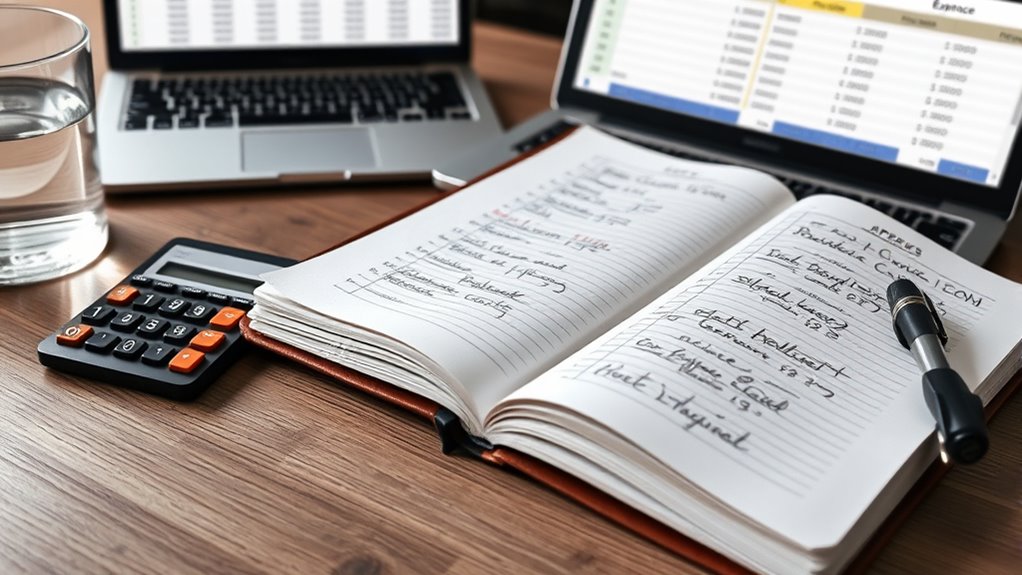
Keeping detailed records of payments made is essential for accurately tracking your care expenses. These records ensure you can substantiate your claims and avoid issues during audits. Use a dedicated ledger or digital spreadsheet to log each payment, noting the date, amount, payee, and service provided. Organizing your records helps you quickly access information when preparing tax documents. Additionally, storing your records securely helps maintain privacy and security of your sensitive information. For example, understanding the types of headphones and their compatibility can be helpful if your care expenses include assistive listening devices or related accessories. Being aware of beneficial ingredients found in products like eye patches can also assist in documenting expenses related to specific treatments or skincare routines. Maintaining accurate records is especially important if your expenses include juice cleanses or related wellness programs, as documentation can support your deductions. Also, understanding payment methods can help you keep track of various ways you settle your expenses effectively.
Track Care-Related Expenses Regularly
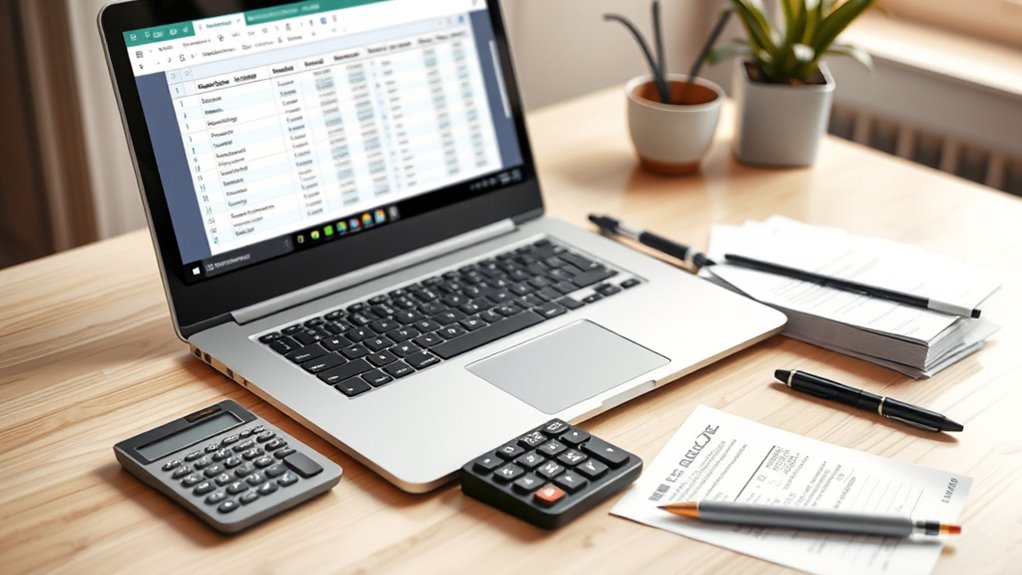
Regularly tracking your care-related expenses guarantees you don’t miss any deductible costs and simplifies the tax filing process. Make it a habit to record every expense as soon as it occurs, whether it’s receipts for medical supplies, transportation costs, or payments to caregivers. Use a dedicated notebook, spreadsheet, or expense-tracking app to stay organized. Incorporating accurate record-keeping practices can also help ensure you’re capturing all relevant expenses and maximizing your deductions. Consistent tracking helps you avoid the stress of searching for receipts later and ensures you have an accurate total of your deductible expenses. Set aside a specific time each week to update your records, so nothing slips through the cracks. Maintaining detailed documentation of your expenses supports your claims and can be crucial if you are audited. Additionally, understanding tax deduction rules related to care expenses can help you identify which costs are eligible for deductions. Monitoring your expenses regularly can also prevent missed opportunities for deductions and ensure you stay compliant with IRS requirements.
Categorize Expenses by Type and Date

To keep your records organized, you should categorize your expenses by type and date. This makes it easier to identify deductible costs and verify them later. Be sure to record each expense with the correct date to guarantee accuracy during tax time. Incorporating organized record-keeping practices, such as maintaining a dedicated ledger or digital file system, can further streamline the process. Additionally, understanding the types of expenses that qualify for deductions can help maximize your tax benefits. Paying attention to recordkeeping methods is essential for ensuring all relevant expenses are properly documented. Employing data-driven strategies can provide measurable results in tracking your expenses effectively.
Sort by Expense Type
Organizing your care expenses by type and date is essential for accurate documentation and easier tax filing. Begin by grouping expenses into categories such as medical supplies, home modifications, or professional services. This helps you quickly identify deductible costs and ensures you don’t overlook any receipts. Next, within each category, arrange the expenses chronologically. Using folders or digital labels can keep everything orderly. Clear categorization makes it easier to verify your totals when preparing your tax return and provides clarity if you’re audited. Be consistent with your labels and organization method throughout the year. This systematic approach saves you time and minimizes errors, making the process smoother and more efficient when it’s time to file your taxes.
Record With Dates
After grouping your care expenses by type, adding dates to each entry helps create a clear timeline of your spending. Recording dates guarantees you can verify when costs occurred, which is vital during tax season. It also helps you identify recurring expenses and spot any discrepancies. Use a simple table to organize your records:
| Date | Expense Type | Amount |
|---|---|---|
| 2024-01-15 | Medical Supplies | $50.00 |
| 2024-02-10 | Transportation | $20.00 |
| 2024-03-05 | Home Care Services | $150.00 |
Keeping detailed dates alongside expense types makes it easier to justify your deductions and provides a clear, organized record for future reference.
Use Digital Tools to Organize Your Documentation
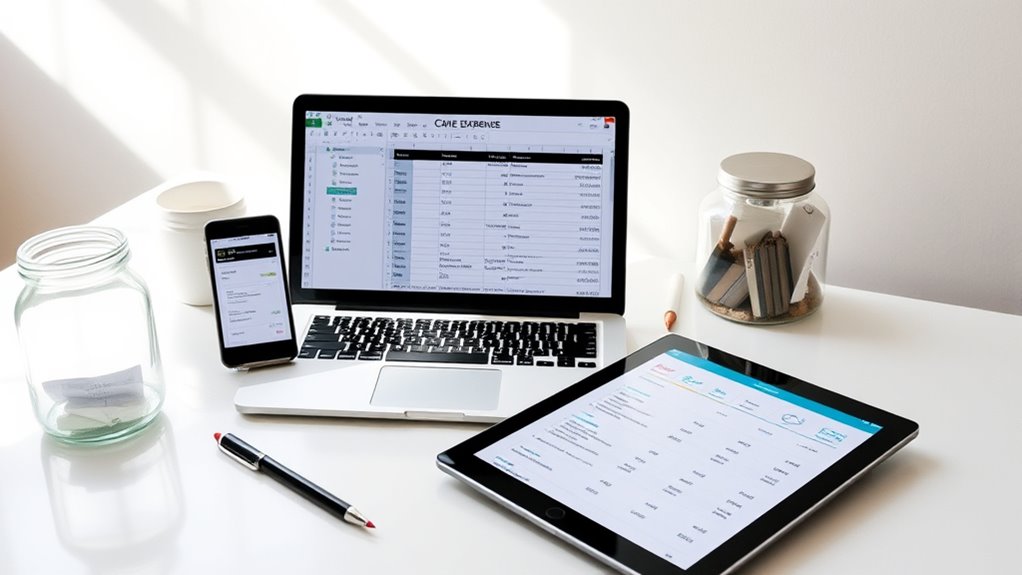
Using digital tools makes organizing your care expenses more efficient. Choose reliable apps that suit your needs, and take advantage of features like scanning receipts quickly. With sync capabilities across devices, you can access your documentation anytime, anywhere.
Choose Reliable Apps
Choosing reliable apps is essential for keeping your care expenses well-organized and easily accessible when it’s time to file your taxes. Look for apps with secure data storage, user-friendly interfaces, and features that suit your needs. Some apps automatically categorize expenses, sync across devices, and allow quick photo uploads of receipts. To help you compare options, consider this table:
| Feature | App A | App B | App C |
|---|---|---|---|
| Data Security | End-to-end encryption | Cloud backup | Two-factor authentication |
| User Interface | Simple and clean | Customizable | Intuitive navigation |
| Expense Categorization | Automatic | Manual tagging | Hybrid approach |
Choosing the right app streamlines tracking and ensures your documentation is dependable come tax time.
Scan Receipts Easily
Digitizing your receipts makes organizing your care expenses more efficient and reduces the risk of losing important documents. Use your smartphone or scanner to quickly capture images of each receipt as soon as possible. Many apps have built-in OCR (optical character recognition) features, which convert images into searchable text, making it easier to categorize and find receipts later. Save these digital copies in clearly labeled folders or within your chosen app to stay organized. Regularly scan new receipts to keep your records up to date and prevent clutter. Avoid waiting until tax season; digitizing receipts promptly guarantees you won’t forget details or misplace documents. With these simple steps, managing your care expenses becomes more streamlined and less stressful.
Sync Across Devices
Since your care expense records are digital, syncing them across your devices makes sure you can access and update your documentation anytime, anywhere. This seamless synchronization guarantees you never lose track of receipts or records, even if you switch devices or experience technical issues. Use cloud-based tools like Dropbox or Google Drive to keep everything current and accessible. To stay organized, consider categorizing expenses, dates, and amounts, so you can quickly find what you need. Here’s a quick overview:
| Device | Purpose | Sync Frequency |
|---|---|---|
| Smartphone | Capture receipts on the go | Real-time |
| Laptop | Review and organize documentation | Daily |
| Tablet | View records during meetings | As needed |
| Cloud Service | Backup and access anywhere | Continuous |
Syncing keeps your records reliable and ready for tax time.
Document the Care Provider’s Details
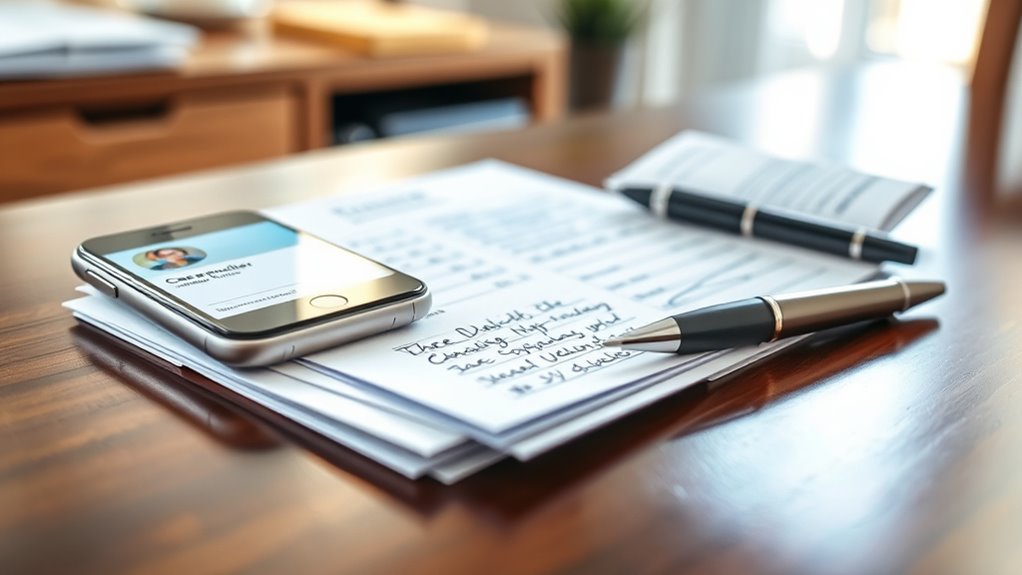
To guarantee your care expenses are properly documented for tax deductions, it’s essential to record the care provider’s full details accurately. This ensures you have verifiable proof of the expense. Start by collecting the provider’s full name, business name (if applicable), and contact information. Next, note their license or registration number, which confirms their legitimacy. Include their address and taxpayer identification number (TIN) or Social Security number, necessary for tax reporting. Additionally, keep a record of the provider’s payment details, such as receipts or invoices that specify the service date and amount paid. These details create a clear audit trail and help prevent potential issues during tax season. Proper documentation simplifies claiming your deductions and provides peace of mind.
Maintain Records of Any Reimbursements or Refunds

Keeping detailed records of any reimbursements or refunds you receive is an important step in documenting your care expenses. These records guarantee you accurately report your out-of-pocket costs and avoid double counting. When you receive a reimbursement, note the date, amount, and source. If refunds are issued, document the reason and date of the refund. Use the table below to organize your reimbursements and refunds:
| Date | Amount | Source/Provider | Refund/ Reimbursement | Notes |
|---|---|---|---|---|
| 01/15/2024 | $200 | Insurance A | Reimbursement | Partial coverage of bill |
| 02/10/2024 | $50 | Medicaid | Refund | Overpayment correction |
| 03/05/2024 | $150 | Care Provider B | Reimbursement | Paid in advance |
| 04/20/2024 | $75 | Insurance C | Refund | Duplicate billing resolved |
Keeping these records organized helps clarify your total deductible expenses and guarantees compliance during tax filing. Additionally, understanding fraud detection techniques can help prevent issues related to erroneous or fraudulent transactions, ensuring your records remain accurate and trustworthy. Recognizing proper documentation practices can further enhance your ability to substantiate your claims if audited. Being aware of audit preparation strategies can also assist you in maintaining accurate documentation and avoiding potential penalties. Moreover, maintaining awareness of document management best practices can improve the efficiency and reliability of your record-keeping process. Incorporating digital record-keeping solutions can streamline your documentation process and reduce the risk of data loss.
Review and Update Your Records Periodically
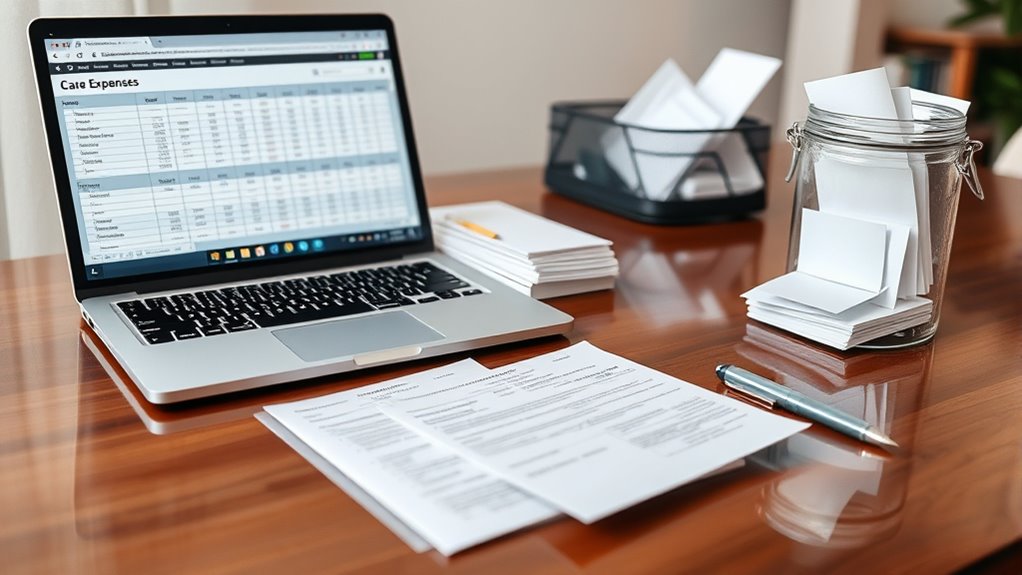
Regularly reviewing and updating your records guarantees that your documentation remains accurate and complete throughout the year. By staying proactive, you prevent errors and ensure all expenses are properly accounted for. Consider these key steps:
- Schedule monthly reviews to catch discrepancies early.
- Update records immediately after any payment or reimbursement.
- Cross-check receipts and statements to verify accuracy.
- Maintain organized digital and physical files for quick access during tax season.
- Incorporate sound healing science insights into your record-keeping practices to better understand how various expenses might relate to wellness or alternative health therapies. Understanding self watering plant pots can also help you track expenses related to plant care if they are part of your business or wellness space. Additionally, being aware of narcissistic behaviors can help you recognize potential manipulative tactics in financial dealings or documentation processes.
Consistent reviews help identify missing documents and prevent last-minute scrambles. It also ensures your records reflect current expenses, making tax filing smoother. Staying vigilant reduces the risk of errors that could delay deductions or trigger audits. Make this a habit, and you’ll keep your documentation reliable and ready whenever you need it.
Frequently Asked Questions
Can I Claim Expenses for Unpaid or Volunteer Caregiving Services?
You can’t claim expenses for unpaid or volunteer caregiving services because IRS rules specify that only paid care costs qualify for deductions. If you pay a caregiver, whether it’s a professional or someone you hire, you can document those expenses. Keep detailed records like receipts and invoices. Volunteer or unpaid services aren’t deductible, but any paid care expenses you incur can be documented and potentially claimed on your taxes.
How Long Should I Retain Care Expense Records for Tax Purposes?
Think of your records as a sturdy bridge connecting you to your tax benefits. You should keep your care expense records for at least three years from the date you file your return or the due date. This way, if the IRS questions your claims, you have a reliable pathway to verify everything. Staying organized and retaining your documents guarantees your financial foundation remains solid and secure.
Are There Specific Formats or Templates Recommended for Documentation?
When documenting care expenses, you should use clear, organized formats like spreadsheets or dedicated expense tracking templates. Keep detailed records of dates, amounts, and service providers. You can also use receipts, invoices, or bank statements as supporting evidence. Consistency is key, so choose a format that’s easy for you to update and review later. This way, you guarantee your documentation is thorough and ready if you need to substantiate your deductions.
How Do I Handle Receipts Lost or Damaged Over Time?
Imagine your receipts are tiny paper soldiers, lost in the chaos of your desk. When they vanish or get damaged, don’t fret. You can replace them with bank statements, canceled checks, or credit card statements showing the expense. Keep diligent digital copies or photocopies of any remaining proof. This backup armor helps you defend your deductions, even if that once-pristine receipt becomes a casualty of time.
What Are Common Mistakes to Avoid When Documenting Care Expenses?
When documenting care expenses, you should avoid common mistakes like not keeping detailed records, mixing personal and care expenses, or failing to get proper receipts. Always verify receipts are legible and include date, amount, and provider details. Don’t forget to categorize expenses clearly and maintain copies in a dedicated folder. Double-check that expenses qualify for deductions to prevent errors that could delay or disqualify your claim.
Conclusion
By meticulously documenting every care expense, you’ll create an ironclad record that could turn your tax season into a breeze—no more sleepless nights or frantic searches for receipts! Keep your files organized, update regularly, and watch as the IRS recognizes your diligence, potentially saving you a fortune. With these steps, you’ll transform a formidable task into an unstoppable fortress of financial proof, making tax deductions feel like child’s play rather than a bureaucratic maze.









